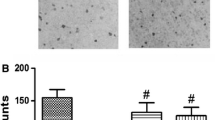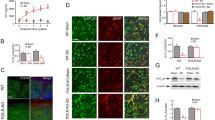Abstract
Sleep apnea disrupts physiologic homeostasis and causes neuronal dysfunction. In addition to signs of mental disorders and cognitive dysfunction, patients with sleep apnea have a higher anxiety rate. Here, we examined the mechanisms underlying this critical health issue. We used a mouse model with sleep-associated chronic intermittent hypoxia (IH) to verify the effects of sleep apnea on neuronal dysfunction. To evaluate how IH alters neuronal function to yield anxiety-like behavior and cognitive dysfunction, we examined synaptic plasticity and neuronal inflammation in related brain areas, including the medial prefrontal cortex (mPFC), striatum, and hippocampus. Mice subjected to chronic IH for 10 days exhibited significant anxiety-like behaviors in the elevated plus maze test. IH mice spent less travel time in open arms and more travel time in enclosed arms compared to control mice. However, cognitive impairment was minimal in IH mice. Increased glutamate N-methyl-D-aspartate (NMDA) receptor subunits 2B (GluN2B) and phosphorylated-ERK1/2 were seen in the mPFC, striatum, and hippocampus of IH mice, but no significant microglial and astrocyte activation was found in these brain areas. Chronic IH in mice induced compensatory increases in GluN2B to disturb neuronal synaptic plasticity, without neuronal inflammation. The altered synaptic plasticity subsequently led to anxiety-like behavior in mice. Treatment with the NMDA receptor antagonist dextromethorphan attenuated chronic IH-induced anxiety-like behavior and GluN2B expression. Our findings provide mechanistic evidence of how IH may provoke anxiety and support for the importance of early intervention to alleviate anxiety-associated complications in patients with chronic sleep apnea.










Similar content being viewed by others
Data Availability
All authors have ensured that all data and materials support the published statement and comply with field standards. The datasets generated during or analyzed during the current study are available from the corresponding author on reasonable request.
Code Availability
The software (Panlab Smart video-tracking software, version 3.0, OLYMPUS cellSens Dimension version 1.13., Prism 5 and SPSS 22) that were used in this study have authorized by the original company.
References
Iacono Isidoro S, Salvaggio A, Lo Bue A, Romano S, Marrone O, Insalaco G (2013) Quality of life in patients at first time visit for sleep disorders of breathing at a sleep centre. Health Qual Life Outcomes 11:207. https://doi.org/10.1186/1477-7525-11-207
Tang X, Zhang M, Zhou N, Yan J, Yang LX, Chen GH (2017) Current status of cognitive dysfunction in patients with obstructive sleep apnea hypopnea syndrome. Lin Chung Er Bi Yan Hou Tou Jing Wai Ke Za Zhi 31(10):813–816. https://doi.org/10.13201/j.issn.1001-1781.2017.10.022
Sharafkhaneh A, Giray N, Richardson P, Young T, Hirshkowitz M (2005) Association of psychiatric disorders and sleep apnea in a large cohort. Sleep 28(11):1405–1411. https://doi.org/10.1093/sleep/28.11.1405
Saunamaki T, Jehkonen M (2007) Depression and anxiety in obstructive sleep apnea syndrome: a review. Acta Neurol Scand 116(5):277–288. https://doi.org/10.1111/j.1600-0404.2007.00901.x
Shapiro AL, Culp S, Azulay Chertok IR (2014) OSA symptoms associated with and predictive of anxiety in middle-aged men: secondary analysis of NHANES data. Arch Psychiatr Nurs 28(3):200–205. https://doi.org/10.1016/j.apnu.2014.02.002
Amdo T, Hasaneen N, Gold MS, Gold AR (2016) Somatic syndromes, insomnia, anxiety, and stress among sleep disordered breathing patients. Sleep Breath 20(2):759–768. https://doi.org/10.1007/s11325-015-1296-6
Ringman JM, Liang LJ, Zhou Y, Vangala S, Teng E, Kremen S, Wharton D, Goate A et al (2015) Early behavioural changes in familial Alzheimer’s disease in the Dominantly Inherited Alzheimer Network. Brain 138(Pt 4):1036–1045. https://doi.org/10.1093/brain/awv004
Fung AW, Chan WC, Wong CS, Chen EY, Ng RM, Lee EH, Chang WC, Hung SF et al (2017) Prevalence of anxiety disorders in community dwelling older adults in Hong Kong. Int Psychogeriatr 29(2):259–267. https://doi.org/10.1017/S1041610216001617
Fung AWT, Lee JSW, Lee ATC, Lam LCW (2018) Anxiety symptoms predicted decline in episodic memory in cognitively healthy older adults: a 3-year prospective study. Int J Geriatr Psychiatry 33(5):748–754. https://doi.org/10.1002/gps.4850
Liu S, Sun JY, Ren LP, Chen K, Xu B (2017) Propofol attenuates intermittent hypoxia induced up-regulation of proinflammatory cytokines in microglia through inhibiting the activation of NF-Bkappa/p38 MAPK signalling. Folia Neuropathol 55(2):124–131. https://doi.org/10.5114/fn.2017.68579
Yang Q, Wang Y, Feng J, Cao J, Chen B (2013) Intermittent hypoxia from obstructive sleep apnea may cause neuronal impairment and dysfunction in central nervous system: the potential roles played by microglia. Neuropsychiatr Dis Treat 9:1077–1086. https://doi.org/10.2147/NDT.S49868
Nair D, Dayyat EA, Zhang SX, Wang Y, Gozal D (2011) Intermittent hypoxia-induced cognitive deficits are mediated by NADPH oxidase activity in a murine model of sleep apnea. PLoS One 6(5):e19847. https://doi.org/10.1371/journal.pone.0019847
Boyce-Rustay JM, Holmes A (2006) Genetic inactivation of the NMDA receptor NR2A subunit has anxiolytic- and antidepressant-like effects in mice. Neuropsychopharmacology 31(11):2405–2414. https://doi.org/10.1038/sj.npp.1301039
Sun H, Jia N, Guan L, Su Q, Wang D, Li H, Zhu Z (2013) Involvement of NR1, NR2A different expression in brain regions in anxiety-like behavior of prenatally stressed offspring. Behav Brain Res 257:1–7. https://doi.org/10.1016/j.bbr.2013.08.044
Delawary M, Tezuka T, Kiyama Y, Yokoyama K, Inoue T, Hattori S, Hashimoto R, Umemori H et al (2010) NMDAR2B tyrosine phosphorylation regulates anxiety-like behavior and CRF expression in the amygdala. Mol Brain 3(1):37. https://doi.org/10.1186/1756-6606-3-37
Polotsky VY, Rubin AE, Balbir A, Dean T, Smith PL, Schwartz AR, O'Donnell CP (2006) Intermittent hypoxia causes REM sleep deficits and decreases EEG delta power in NREM sleep in the C57BL/6 J mouse. Sleep Med 7(1):7–16. https://doi.org/10.1016/j.sleep.2005.06.006
Nair D, Ramesh V, Li RC, Schally AV, Gozal D (2013) Growth hormone releasing hormone (GHRH) signaling modulates intermittent hypoxia-induced oxidative stress and cognitive deficits in mouse. J Neurochem 127(4):531–540. https://doi.org/10.1111/jnc.12360
Xu W, Chi L, Row BW, Xu R, Ke Y, Xu B, Luo C, Kheirandish L et al (2004) Increased oxidative stress is associated with chronic intermittent hypoxia-mediated brain cortical neuronal cell apoptosis in a mouse model of sleep apnea. Neuroscience 126(2):313–323. https://doi.org/10.1016/j.neuroscience.2004.03.055
Edlund MJ, McNamara ME, Millman RP (1991) Sleep apnea and panic attacks. Compr Psychiatry 32(2):130–132. https://doi.org/10.1016/0010-440x(91)90004-v
Su VY, Chen YT, Lin WC, Wu LA, Chang SC, Perng DW, Su WJ, Chen YM et al (2015) Sleep apnea and risk of panic disorder. Ann Fam Med 13(4):325–330. https://doi.org/10.1370/afm.1815
Diaz SV, Brown LK (2016) Relationships between obstructive sleep apnea and anxiety. Curr Opin Pulm Med 22(6):563–569. https://doi.org/10.1097/MCP.0000000000000326
Rezaeitalab F, Moharrari F, Saberi S, Asadpour H, Rezaeetalab F (2014) The correlation of anxiety and depression with obstructive sleep apnea syndrome. J Res Med Sci 19(3):205–210
Gupta MA, Simpson FC (2015) Obstructive sleep apnea and psychiatric disorders: a systematic review. J Clin Sleep Med 11(2):165–175. https://doi.org/10.5664/jcsm.4466
Lehto SM, Sahlman J, Soini EJ, Gylling H, Vanninen E, Seppa J, Viinamaki H, Tuomilehto H (2013) The association between anxiety and the degree of illness in mild obstructive sleep apnoea. Clin Respir J 7(2):197–203. https://doi.org/10.1111/j.1752-699X.2012.00304.x
Gold MS, Amdo T, Hasaneen N, Gold AR (2016) Somatic arousal and sleepiness/fatigue among patients with sleep-disordered breathing. Sleep Breath 20(2):749–758. https://doi.org/10.1007/s11325-015-1294-8
Lee SA, Han SH, Ryu HU (2015) Anxiety and its relationship to quality of life independent of depression in patients with obstructive sleep apnea. J Psychosom Res 79(1):32–36. https://doi.org/10.1016/j.jpsychores.2015.01.012
Martinez-Garcia MA, Chiner E, Hernandez L, Cortes JP, Catalan P, Ponce S, Diaz JR, Pastor E et al (2015) Obstructive sleep apnoea in the elderly: role of continuous positive airway pressure treatment. Eur Respir J 46(1):142–151. https://doi.org/10.1183/09031936.00064214
Lago T, Davis A, Grillon C, Ernst M (2017) Striatum on the anxiety map: Small detours into adolescence. Brain Res 1654(Pt B):177–184. https://doi.org/10.1016/j.brainres.2016.06.006
Davis DM, Jacobson TK, Aliakbari S, Mizumori SJ (2005) Differential effects of estrogen on hippocampal- and striatal-dependent learning. Neurobiol Learn Mem 84(2):132–137. https://doi.org/10.1016/j.nlm.2005.06.004
Calhoon GG, Tye KM (2015) Resolving the neural circuits of anxiety. Nat Neurosci 18(10):1394–1404. https://doi.org/10.1038/nn.4101
Ben Simon E, Rossi A, Harvey AG, Walker MP (2020) Overanxious and underslept. Nat Hum Behav 4(1):100–110. https://doi.org/10.1038/s41562-019-0754-8
Klumpers F, Kroes MC, Heitland I, Everaerd D, Akkermans SE, Oosting RS, van Wingen G, Franke B et al (2015) Dorsomedial prefrontal cortex mediates the impact of serotonin transporter linked polymorphic region genotype on anticipatory threat reactions. Biol Psychiatry 78(8):582–589. https://doi.org/10.1016/j.biopsych.2014.07.034
Balsara R, Dang A, Donahue D, Snow T, Castellino F (2015) Conantokin-G attenuates detrimental effects of NMDAR hyperactivity in an ischemic rat model of stroke. PLOS ONE 10:e0122840. https://doi.org/10.1371/journal.pone.0122840
Liu Y, Ji ES, Xiang S, Tamisier R, Tong J, Huang J, Weiss JW (2009) Exposure to cyclic intermittent hypoxia increases expression of functional NMDA receptors in the rat carotid body. J Appl Physiol (1985) 106(1):259–267. https://doi.org/10.1152/japplphysiol.90626.2008
Coleman CG, Wang G, Park L, Anrather J, Delagrammatikas GJ, Chan J, Zhou J, Iadecola C et al (2010) Chronic intermittent hypoxia induces NMDA receptor-dependent plasticity and suppresses nitric oxide signaling in the mouse hypothalamic paraventricular nucleus. J Neurosci 30(36):12103–12112. https://doi.org/10.1523/JNEUROSCI.3367-10.2010
Husi H, Ward MA, Choudhary JS, Blackstock WP, Grant SG (2000) Proteomic analysis of NMDA receptor-adhesion protein signaling complexes. Nat Neurosci 3(7):661–669. https://doi.org/10.1038/76615
Sheng M, Kim MJ (2002) Postsynaptic signaling and plasticity mechanisms. Science 298(5594):776–780. https://doi.org/10.1126/science.1075333
Netzer R, Pflimlin P, Trube G (1993) Dextromethorphan blocks N-methyl-D-aspartate-induced currents and voltage-operated inward currents in cultured cortical neurons. Eur J Pharmacol 238(2-3):209–216
Taylor CP, Traynelis SF, Siffert J, Pope LE, Matsumoto RR (2016) Pharmacology of dextromethorphan: relevance to dextromethorphan/quinidine (Nuedexta(R)) clinical use. Pharmacol Ther 164:170–182. https://doi.org/10.1016/j.pharmthera.2016.04.010
Acknowledgments
The authors thank Rebecca Bartow, PhD, of the Department of Scientific Publications at the Texas Heart Institute, Houston, Texas, for editorial assistance.
Funding
This study was supported by grant M109108 (to SLC) from Kaohsiung Medical University and the grants #105-2628-B-037-003-MY3 (to SLC) and #107-2321-B-037-002 (to CKL) from the Taiwan Ministry of Science and Technology.
Author information
Authors and Affiliations
Contributions
Yun Fa and Mei-Chuan Chou performed most of the experiments; Yen-Chin Liu, Ching-Kuan Liu, and Chu-Huang Chen helped with the parts of the experiments and revised the manuscript; Yun Fa, Mei-Chuan Chou, and Shiou-Lan Chen designed the study, analyzed the data, and wrote the manuscript. All authors read and approved the final manuscript.
Corresponding author
Ethics declarations
Ethics Approval
All animal experiments were approved by the Institutional Animal Care and Use Committee (IACUC) of the Kaohsiung Medical University and carried out in accordance with AAALAC regulations, the US Department of Agriculture Animal Welfare Act, and the Guide for the Care and Use of Laboratory Animals of the NIH.
Consent to Participate
This study did not include the human subjects.
Consent for Publication
This study did not include the human subjects.
Conflicts of Interest
The authors declare that they have no conflict of interest.
Additional information
Publisher’s Note
Springer Nature remains neutral with regard to jurisdictional claims in published maps and institutional affiliations.
Rights and permissions
About this article
Cite this article
Fan, Y., Chou, MC., Liu, YC. et al. Intermittent Hypoxia Activates N-Methyl-D-Aspartate Receptors to Induce Anxiety Behaviors in a Mouse Model of Sleep-Associated Apnea. Mol Neurobiol 58, 3238–3251 (2021). https://doi.org/10.1007/s12035-021-02321-0
Received:
Accepted:
Published:
Issue Date:
DOI: https://doi.org/10.1007/s12035-021-02321-0




